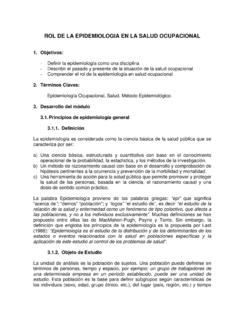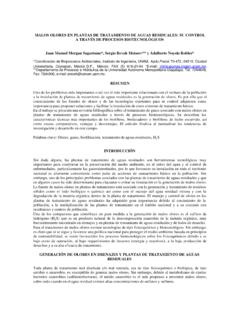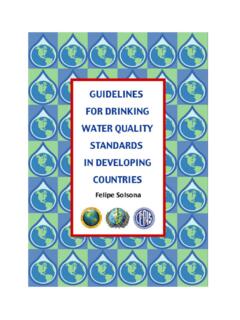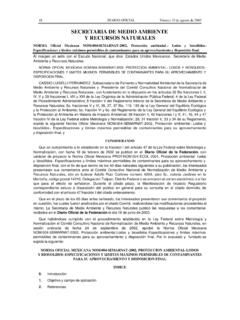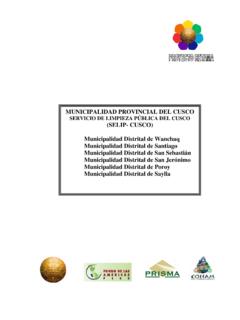Transcription of ENVIRONMENTAL PLANNING FOR SUSTAINABLE …
1 ENVIRONMENTAL PLANNING FOR SUSTAINABLE urban DEVELOPMENT for Caribbean Water and Wastewater Association 9th Annual Conference & Exhibition at Chaguaramas, trinidad , 2 - 6 October 2000 by ENG. RONALD A. WILLIAMS Consulting ENVIRONMENTAL Engineer Port of Spain ENVIRONMENTAL PLANNING FOR SUSTAINABLE urban DEVELOPMENT * 1. INTRODUCTION Urbanization Physical PLANNING ENVIRONMENTAL Health Management SUSTAINABLE Development 2. HUMAN SETTLEMENTS AND SUSTAINABILITY Communities and Their Environment ENVIRONMENTAL Needs and Impacts Aggravating Factors Improving the urban Environment Policy Issues and Instruments 3. SUSTAINABLE DEVELOPMENT Development and Sustainability Greening the City Healthy Communities, Healthy Island SUSTAINABLE Communities 4. urban ENVIRONMENTAL MANAGEMENT STRATEGIES urban ENVIRONMENTAL Management ENVIRONMENTAL Problems Policy Messages Strategies Eco-city PLANNING Initiatives Conventional PLANNING Ecosystem PLANNING Valuing urban ENVIRONMENTAL Problems SUSTAINABLE Community Building Blocks Stakeholder Participation 5.
2 MOBILIZING SUSTAINABILITY IN urban AREAS The Role of Governance Non-Government Inputs Private Sector Involvement Non-Government Organizations (NGOs) Other Participants Tools for Community Sustainability Community Tools Technical Tools Tools in Action 6. CONCLUSIONS AND RECOMMENDATIONS References Boxes: 1. Modern ENVIRONMENTAL Health Engineering 2. Key ENVIRONMENTAL Issues of UNCED-92 3. ENVIRONMENTAL Technology in SUSTAINABLE Development 4. Stages in Stakeholder Participation 5. ICC Business Charter for SUSTAINABLE Development: Principles for ENVIRONMENTAL Management Appendices: 1. Increasing Access to Water and Sanitation Services in Poor urban Areas through Private Investment. 1. INTRODUCTION Urbanization In the Caribbean and other developing regions, urban areas and populations are growing.
3 Cities are both engines for growth and sources of concentrated ENVIRONMENTAL problems. People flock to urban areas to seek employment, entertainment, shopping, and a generally higher standard of living. At the same time ENVIRONMENTAL infrastructure of works and services are inadequate to serve the resulting increases in population and population densities. The inevitable congestion causes ENVIRONMENTAL hazards and degradation until strategies for reversing ENVIRONMENTAL deterioration can be implemented. The magnitude of urban population growth in developing countries is a direct indicator of the degree of spatial concentration of people, industries, commerce, vehicles, energy consumption, water use, waste generation, and other ENVIRONMENTAL stresses. Generally, most countries seek to generate increasing economic development which tend to exacerbate such problems which may exceed both the preventive and solution capacity of the government as well as the assimilative capacity of nature.
4 Another determinant of the severity of ENVIRONMENTAL conditions within and around urban areas is their regional ecosystem type, such as: coastal, humid-tropical, mountainous, riverine, ..etc. These urban ecological types are also critical factors in determining optimum ENVIRONMENTAL strategies and plans for specific and SUSTAINABLE urban development. An important goal in the new millennium is to make existing and new urban areas more self-sufficient, SUSTAINABLE , and enjoyable places to live. Physical PLANNING Land-use PLANNING is a complex process involving development of a land-use to include a statement of land-use issues, goals, and objectives; summary of data collection and analysis; land-classification map; and report describing and indicating appropriate development in areas of special ENVIRONMENTAL concern. Because land use decisions are critical determinants of ENVIRONMENTAL quality it is imperative that land use controls be effectively practiced to combat such problems as pollution, the occupation of hazard-prone areas, the degradation of wetlands and other coastal resources, and the loss of open space and other cultural resources.
5 The ways to accomplish these are: Land Use and Maintenance: Ecological land-use PLANNING , building/area restoration, open space preservation, tree planting, community gardens, ..etc. Energy Efficiency: Energy efficient buildings and energy conservation in general Water: Water conservation, and wastewater reuse. Food: Increased food growing using less synthetic chemicals. Pollution Control: Recycling of food and other solid wastes, reduction of industrial wastes, enforcing air/noise pollution control. Economic Development: Increases in investment and social services in rural areas to reduce the move into urban areas. Population Growth: Reduction in national population growth rate. ENVIRONMENTAL Health Management ENVIRONMENTAL health engineering is a main feature of ENVIRONMENTAL health management and is normally defined as "the branch of engineering that is concerned with protecting the environment from the potentially deleterious effects of human activity, protecting human populations from the effects of adverse ENVIRONMENTAL factors, and improving ENVIRONMENTAL quality for human health and well-being.
6 " An inventory of such engineering responsibilities would include: - ENVIRONMENTAL PLANNING of infrastructural works and services; - Resource pollution/degradation prevention (Air, Water, Land, Energy) - Waste management (liquid and solid) - Public health aspects (food safety, vector control) - Housing, institutions and the built environment - ENVIRONMENTAL emergencies (natural and man-made) Thirteen features of modern ENVIRONMENTAL health engineering are at Box 1. Also included are the synergistic demands of cross-sectoral activities. The ENVIRONMENTAL health engineer adapts the principles of natural physical, chemical and biological systems to engineered systems for water supply, waste disposal, pollution control,..etc. His unique role is to utilize modern engineering techniques in copying the self-cleansing mechanisms of nature while accommodating the constraints and limitations.
7 The goal of this engineering sub-discipline (of civil engineering) is to harmonize the powers of technology with the potentialities of natural processes. SUSTAINABLE Development Development is about improving the well-being of people. Raising living standards and improving education, health, and equality of opportunity are all desirable and are essential components of economic development, which were fully practised in trinidad and Tobago in the sixties after independence was won - 31, August 1962. But 5-year development programmes and the establishment of industrial development institutions ( Industrial Development Corporation) helped to promote economic growth which led to ENVIRONMENTAL deterioration in the absence of an effective national ENVIRONMENTAL management programme. Also, such growth took little notice of the social aspects of development, urban or otherwise; and the neglect of human welfare was felt at all levels of society.
8 SUSTAINABLE development, on the other hand, is development that lasts, because in addition to an economic component, there are social and ENVIRONMENTAL components. So that SUSTAINABLE development must be a pro-active strategy to develop sustainability. As it was proposed initially by the World Commission on Environment and Development (1987) SUSTAINABLE development must meet "the needs of the present without compromising the ability of future generations to meet their own needs." SUSTAINABLE development requires mobilizing governments, the private sector, and the general public toward SUSTAINABLE communities. And " SUSTAINABLE urban development is ultimately a cultural statement about ourselves, how we want to live, and our ability to manage our needs, desires, and dreams in ways that are effective and caring.
9 " (See the key ENVIRONMENTAL Issues of the UN Conference on Environment and Development, Rio de Janeiro, June 1992) 2. HUMAN SETTLEMENTS AND SUSTAINABILITY Communities and Their Environment ENVIRONMENTAL Needs and Impacts The most critical urban ENVIRONMENTAL needs by people in developing countries include: Provision of healthful housing and other built environments ( schools, ) Access to ENVIRONMENTAL infrastructure systems and services ( water supply, sewerage, solid waste management, storm drainage, urban transport,..etc.) Availability of open spaces in terms of properly designed community parks and other green areas. ENVIRONMENTAL surveillance and cleaning services for public buildings and outdoor areas. The most important adverse impacts on the urban environment affecting people and caused by man and nature are: Water pollution and depletion Energy use and wastage Air pollution: - Outdoor, by industrialization and motorization emissions, and - indoor, from household and occupational sources Solid waste, especially hazardous waste, when improperly discharged by households and industries.
10 Resource Losses: - Groundwater contamination and depletion - Land and ecosystem degradation - Degradation of historic structures and cultural resources ENVIRONMENTAL hazards: - Natural disasters ( hurricane, earthquake, volcano, flooding,..etc.) - Man-made hazards ( chemical spills and other industrial accidents) Aggravating Factors Factors aggravating urban ENVIRONMENTAL degradation or perpetuating the lack of appropriate preventive and curative ENVIRONMENTAL actions, are: - Lack of public and political awareness - Need for public pressure and political will - Lack of effective public education and participation - Inadequate governance ( Weak institutional capacity, Poor inter-sectoral coordination, Lack of effective public accountability, Inadequate regulatory policies, Unclear property rights, Inefficient economic policies, Insufficient knowledge and information, Shortage of ENVIRONMENTAL professionals).
